Complex numbers (en)
Refresher, complex numbers ...
 Basic properties of complex numbers
Basic properties of complex numbers
Definitions
A common, real number is usually illustrated as a point on the so-called number line. The magnitude is represented by the distance from the point in question to zero.
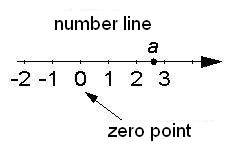
A complex number z consists of two components. It can be written as a + jb. Here, a and b are real numbers. j is the square root of -1 and is called the imaginary unit. a is the complex number real part Re (Z). b is the imaginary part, Im (Z).
Every complex number can be represented as a point in a two-dimensional coordinate system, the complex plane.
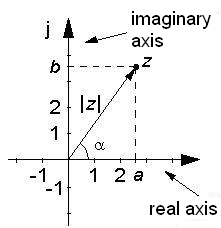
Number z is represented by a point with coordinates a and b.
The distance from the point to the origin represents the amount or number value |z|.
![]()
or
![]()
The angle α is called the argument of z, arg(z) and as seen in the figure

or

We can also express z in polar form, eg with |z| and α. As seen in the figure

One can then imagine that it's the connecting line between the point and the origin that represents the number. We can see this as a pointer (vector) with the length |z| och en direction that is defined by the angle α.
Basic properties
Complex numbers can be treated algebraically, the following rules apply.
Addition
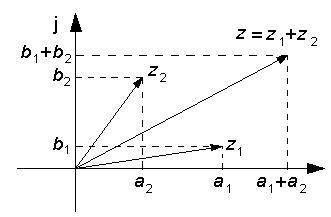

The figure shows what the addition means in the complex plane. The pointer of z equals the geometric sum of the pointers of z1 and z2. For |z| and arg(z) applies the previously mentioned general terms.
Subtraction
![]()
In the complex plane z equals the geometric difference between the z1 och z2.
Multiplication
The multiplication rule, we demonstrate most easily with an example.

The multiplication can also be implemented with the numbers expressed in polar form.
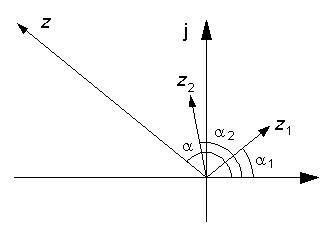

This means that
![]()
Division
Algebraic the division is implemented like this:

Now, one often wants to have the results in the form a+jb and if so, one extends the denominator with the conjugates quantity a2 - jb2. Then one gets

If numbers are expressed in polar form, the division rule that look like this:
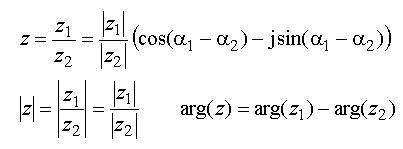
Some memory rules
-
If z = z1 + z2, so is generally |z| ≠ |z1| + |z2|
( only if arg(z1) = arg(z2) then |z| = |z1| + |z2| ) -
When calculating the amount of a product or a quotient of two complex numbers z1 ochz2 it is generally unnecessary to first calculate the complex result and then form the absolute value. One calculates instead |z1| and |z2| separately, for as we have seen applies

Example
Example 1
Redo the expression 2+3/j to form a+jb.

Example 2
Write expression z = 6 + jA + 1/(jB) in the general form of complex numbers, and write a expression for the amount.
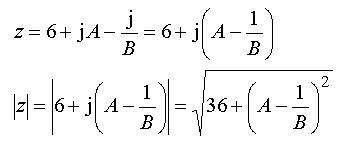
Example 3
Determine |z| and arg(z) when z = z1·z2 and z1 = j and z2 = -1 -j
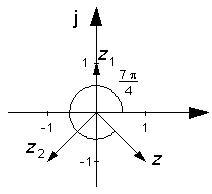
Algebraic
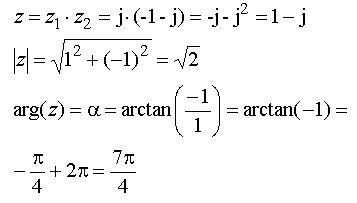
Polar
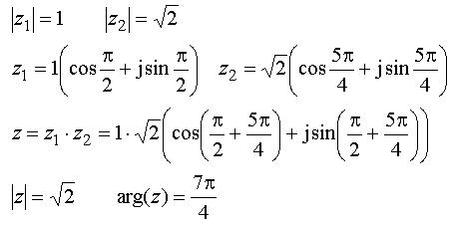
Example 4
z1 = 3 + j5, z2 = 5 + j7. Calculate

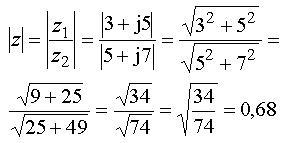
If instead multiplied with conjugate quantity the calculations had been
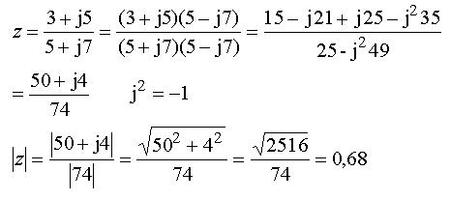
If one compares the above one can see that complex conjugation involves much more work!
Exercises
Question 1
In which direction points the complex pointer z = -2 + j2 ?
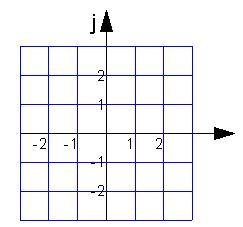
Question 2
What is the sum of z1 and z2 if z1 = 1 + j2 and z2 = 2 - j ?
Question 3
How long is the pointer 3 + j4 ?
Question 4
Draw the pointer z = z1 - z2 if z1 = 1 + j and z2 = 2 + j ?

Question 5
How large is Im(z) if z = z1 + z2 ?
z1 = 3(1+j) and z2 = 2(1-j) .
Question 6
How large is |z| if z = z1·z2 ?
z1 = 2 + j and z2 = -(2 + j) .
Question 7
What will be |3+j4|· |j2| ?
Question 8
Determine |z| and arg(z) if z = z1·z2 and z1 = 1 + j and z2 = -1 + j .

Question 9
What will be z = z1·z2 if z1 = j and z2 = 1 - j .

Question 10
What is |z| ?

Question 11
Calculate z.
z1 = 2 + j3 and z2 = 1 + j .


This exercise booklet has been given to me by Per-Erik Lindahl. It has been used as an aid in courses of basic circuit theory at KTH.